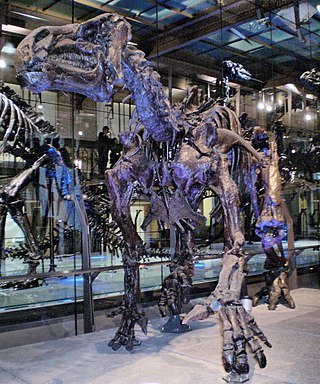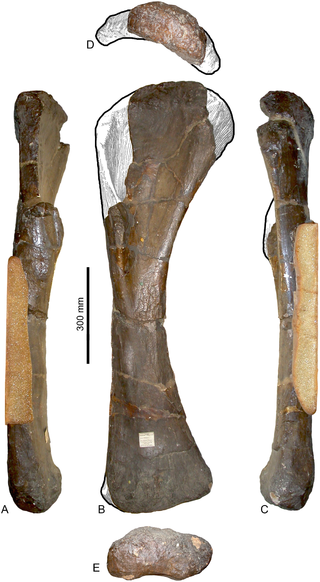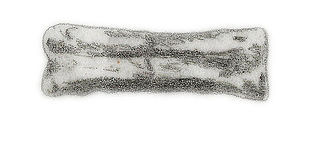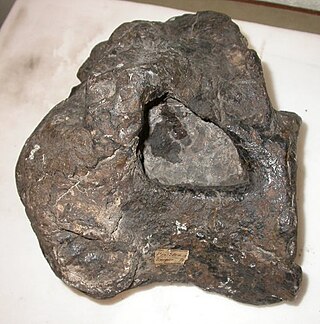
Iguanodon, named in 1825, is a genus of iguanodontian dinosaur. While many species found worldwide have been classified in the genus Iguanodon, dating from the Late Jurassic to Early Cretaceous, taxonomic revision in the early 21st century has defined Iguanodon to be based on one well-substantiated species: I. bernissartensis, which lived during the Barremian to early Aptian ages of the Early Cretaceous in Belgium, Germany, England, and Spain, between about 126 and 122 million years ago. Iguanodon was a large, bulky herbivore, measuring up to 9–11 metres (30–36 ft) in length and 4.5 metric tons in body mass. Distinctive features include large thumb spikes, which were possibly used for defense against predators, combined with long prehensile fifth fingers able to forage for food.

Pelorosaurus is a genus of titanosauriform sauropod dinosaur. Remains referred to Pelorosaurus date from the Early Cretaceous period, about 140-125 million years ago, and have been found in England and Portugal. Thomas Holtz estimated its length at 24 meters.
Apatodon is a dubious genus of dinosaur that may have been a theropod. The type, and only species, A. mirus, was named in 1877 by Othniel Charles Marsh. It was found in the Late Jurassic-aged Morrison Formation of Colorado.

Altispinax is a genus of large predatory theropod dinosaur from the Early Cretaceous period of what is now the Wadhurst Clay Formation of East Sussex, England.
Campylodoniscus is a genus of titanosaur sauropod dinosaur from the Late Cretaceous Period of what is now Argentina.

Teinurosaurus is a genus of carnivorous theropod dinosaur. Teinurosaurus lived during the Late Jurassic in what is now France. The type species is Teinurosaurus sauvagei. It's been estimated to be 11.4 m in length and 3.6 tonnes in weight.

Regnosaurus is a genus of herbivorous stegosaurian dinosaur that lived during the Early Cretaceous Period in what is now England. It was one of the first stegosaurs disvovered.
Albisaurus was once thought to be a genus of dinosaur, but is now thought to be a non-dinosaurian archosaur. It was first described by Antonin Fritsch, a Czech palaeontologist, in 1893, but the remains are sparse. The validity of the species cannot be proven based on the fossil remains, and it is usually marked as a nomen dubium. It lived during the Turonian-Santonian stages of the Cretaceous period.

Mochlodon is a genus of rhabdodontid dinosaurs from the Late Cretaceous of Austria and Hungary. It lived during the Late Cretaceous and two species are known: M. suessi and M. vorosi.

Ornithopsis is a genus of sauropod dinosaur, from the Early Cretaceous of England. The type species, which is the only species seen as valid today, is O. hulkei, which is only known from fragmentary remains, and has been regarded by many authors as dubious.

Thecocoelurus is a dubious genus of theropod dinosaur from the early Cretaceous period of England. The phylogenetic placement of this genus is uncertain, and it has been referred to an oviraptosaur, an ornithomimosaur, or a therizinosaur by different researchers throughout its history.

Teratosaurus is a genus of rauisuchians known from the Triassic Stubensandstein of Germany. It is estimated to be 6.2 meters (20.35 ft) long.
Loncosaurus is an extinct genus of ornithopod dinosaur from the Upper Cretaceous of Provincia de Santa Cruz, Argentina. The type species is Loncosaurus argentinus, described by the famous Argentinian paleontologist Florentino Ameghino, but is considered a dubious name. Details on this animal are often contradictory, befitting a genus that was long confused for a theropod.

Cretornis is a pterosaur genus from the late Cretaceous period of what is now the Jizera Formation in the Czech Republic, dating to about 92 million years ago. It only contains a single species, Cretornis hlavaci.
Paleontology or palaeontology is the study of prehistoric life forms on Earth through the examination of plant and animal fossils. This includes the study of body fossils, tracks (ichnites), burrows, cast-off parts, fossilised feces (coprolites), palynomorphs and chemical residues. Because humans have encountered fossils for millennia, paleontology has a long history both before and after becoming formalized as a science. This article records significant discoveries and events related to paleontology that occurred or were published in the year 1902.
Paleontology or palaeontology is the study of prehistoric life forms on Earth through the examination of plant and animal fossils. This includes the study of body fossils, tracks (ichnites), burrows, cast-off parts, fossilised feces (coprolites), palynomorphs and chemical residues. Because humans have encountered fossils for millennia, paleontology has a long history both before and after becoming formalized as a science. This article records significant discoveries and events related to paleontology that occurred or were published in the year 1905.
The Priesener Formation is a Coniacian geologic formation in the Czech Republic. Dinosaur remains diagnostic to the genus level are among the fossils that have been recovered from the formation.
"Megalosaurus" dunkeri is a dubious species of theropod dinosaur, known only from a single tooth.
Iserosaurus is an extinct genus of sea turtle from the Late Cretaceous of Czech Republic.

František Bayer was a Czech zoologist, paleontologist and teacher. He taught at secondary schools before becoming director of the Jiráskovo Gymnasium in Prague. In his spare time he worked on the Cretaceous vertebrates of the region. He specialized in the fishes although he also described birds, amphibians and reptiles. The taxonomic affinities of some of the taxa he described have since been redetermined. He also took an interest in music, both composing and writing about music.











